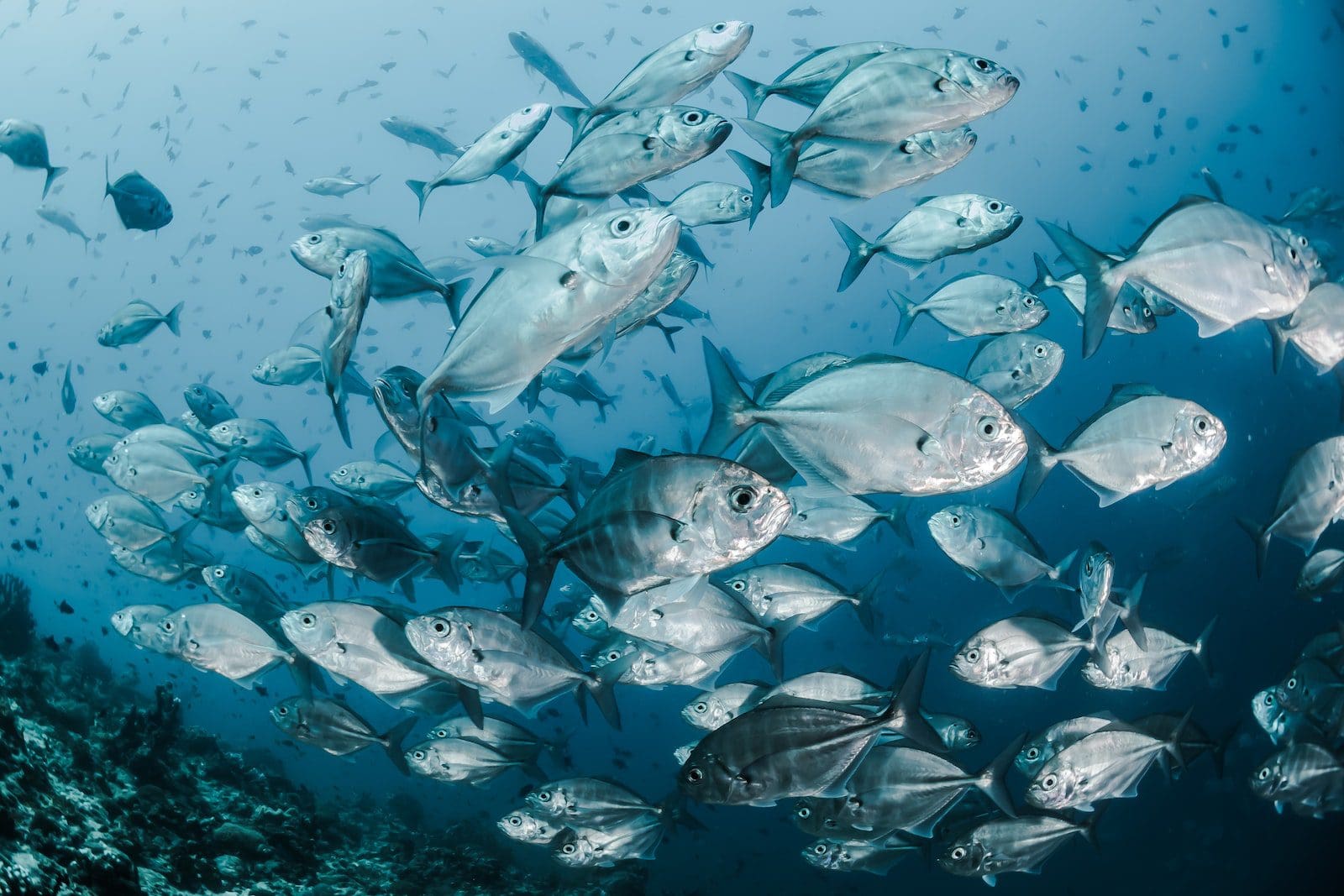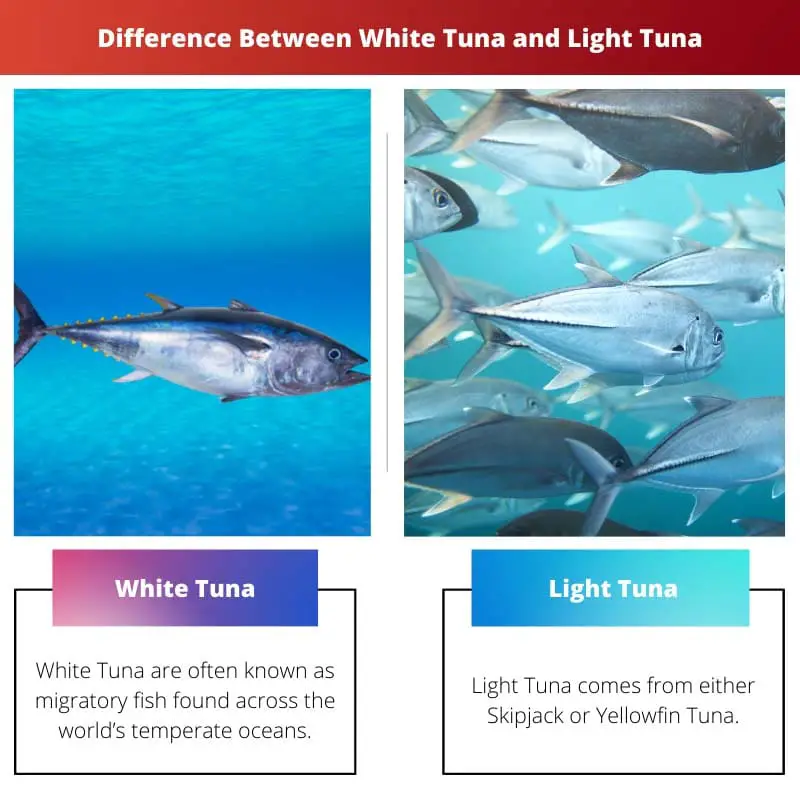Tuna, also called tunny, is a seawater fish that belongs to the family ‘Scombridae’. There are various types of tuna, among which White tuna and Light tuna are highly edible.
White tuna and Light tuna vary in their taste, nutritious components, and quality. It is available in canned form.
Key Takeaways
- White tuna comes from the albacore species, featuring a mild flavor, firm texture, and higher levels of omega-3 fatty acids. In contrast, light tuna includes various species, such as skipjack, yellowfin, and tongol, offering a stronger flavor and a softer texture.
- White tuna has a higher mercury content than light tuna, making light tuna a safer choice for regular consumption, especially for pregnant women and children.
- Light tuna is more affordable and widely available than white tuna, making it a popular choice for canned tuna products.
White Tuna vs Light Tuna
White tuna is also known as albacore tuna and is a larger, more mature fish that has a milder flavour and a firmer texture. Light tuna refers to several smaller species of tuna, such as skipjack, yellowfin, and tongue, and has a darker color and a stronger flavour compared to white tuna.

White Tuna has a waxy texture and is rich in buttery taste. White Tuna is believed to have more calories. It is rich in omega-3 fatty acids.
In the case of quality and taste, White Tuna is the most preferred edible fish. White Tuna comes with white flesh.
Light Tuna has a texture that is similar to chicken thigh. It is soft and more flavorful when compared to White Tuna.
Light Tuna is darker in color, which lies in between a light tan to dark pink. Light tuna has low fat and omega-3 fatty acids when compared to White tuna.
Comparison Table
| Parameters of Comparison | White Tuna | Light Tuna |
|---|---|---|
| Definition | White Tuna are known as migratory fish found across the world’s temperate oceans. | Light Tuna comes from either Skipjack or Yellowfin Tuna. |
| Life span | White Tuna has a life span of 10-12 years and they reach maturity around 5-6 years. | Light Tuna has a life span of 7 years. |
| Color | They are lighter in color and flakier in texture. | Light Tuna is dark red in color and soft. |
| Omega-3 fatty acids | White Tuna is rich in omega-3 fatty acids. | Light Tuna is low in omega-3 fatty acids. |
| Vitamins | White Tuna is high in vitamin B12 and selenium. | It is rich in Vitamin A. |
What is White Tuna?
White Tuna is also called Albacore Tuna. It is found in the world’s warm and tropical waters. It is also called Long Fin Tuna. It is lighter in color and texture. White Tuna is very milder in taste.
When cooked, White Tuna steaks firm up and is delicious with a mild taste.
White Tuna is affordable, and it is sushi-worthy seafood. It has high protein content and is low in fat. They are referred to as pharmaceutical food by many nutritionists.
They are known as nutritional powerhouses. They are easy to cook and delicious.
They have higher amounts of mercury and are safe to consume.
It has been advised to limit the intake of White Tuna during pregnancy. There are many ways to create delicious recipes using White Tuna.
They are healthy and protein-packed. White Tuna is overcooked. They are delicious when made into sandwiches and salads.
White Tuna are larger in size, with a firm texture. It is sold as a solid pack or chunk style with large pieces of White Tuna.
Only one particular species of Tuna is considered White Tuna, which is Albacore Tuna or Thunnus Alalunga. Other types would collectively be called Light Tuna.

What is Light Tuna?
The Light Tuna category includes a number of fish. It commonly comes from either Skipjack or Yellowfin Tuna.
It is packed in a can with water. It comes in a chunk pack with small pieces of it. It is more flavorful than White Tuna.
The meat is darker in color than White Tuna.
Light Tuna is rich in protein. It has less mercury content when compared to White Tuna.
This type of Tuna is great for sandwiches, salads, melts, and casseroles, which is both appetizing and healthy when compared to White Tuna.
Light Tuna weighs about 400 pounds ranging from approximately 190 kg, and its length is nearly 7 feet. Light Tuna has a life span of about 5-10 years.
Light Tuna contains 0.12 parts per million of mercury. They are prepared in many ways, making them delicious and healthy as they have less mercury and more protein.
Light Tuna is preferred over White Tuna for various reasons. Light Tuna has more nutritious facts and benefits than White tuna.
One thing that makes Light Tuna superior to White Tuna is its mercury content and nutritional factors. Light Tuna appears to be similar to Chicken thigh in texture and color.

Main Differences Between White Tuna and Light Tuna
- Light Tuna is canned in water, whereas White Tuna is canned in vegetable oil.
- White Tuna is rich in omega-3 fatty acids, which is less in the case of Light Tuna.
- Light Tuna has less mercury content, whereas White Tuna has 3 times more Mercury content. Consuming Tuna, which is less in mercury content, is regarded as nutritious.
- White Tuna is less flavoured when compared to Light Tuna. Which makes it more delicious and appetizing.
- White Tuna has 23g of proteins, which is high in the case of Light Tuna. Light Tuna has vitamin B12 and Selenium.
- Light Tuna is a category that has various types of tuna in it. Whereas White Tuna is Albacore Tuna.

- https://onlinelibrary.wiley.com/doi/abs/10.1111/j.1365-2621.1996.tb10972.x
- https://www.sciencedirect.com/science/article/pii/S0889157516302101

The detailed descriptions of White Tuna and Light Tuna’s texture and taste were very helpful. This has expanded my understanding of these fish significantly.
I couldn’t agree more. Understanding the differences in taste and texture has given me a new appreciation for these types of tuna.
The information about the lifespan and color differences between White Tuna and Light Tuna was particularly interesting to me. I appreciate the depth of information provided.
I agree, the lifespan and color differences were fascinating. It’s clear that there’s a lot more to consider than just flavor.
Yes, the comparison table was very helpful in summarizing these differences.
Thank you for the insightful comparison of White Tuna and Light Tuna. It’s great to have this in-depth information about the different types of tuna.
I agree. I had no idea there were so many differences between White Tuna and Light Tuna. This was very informative.